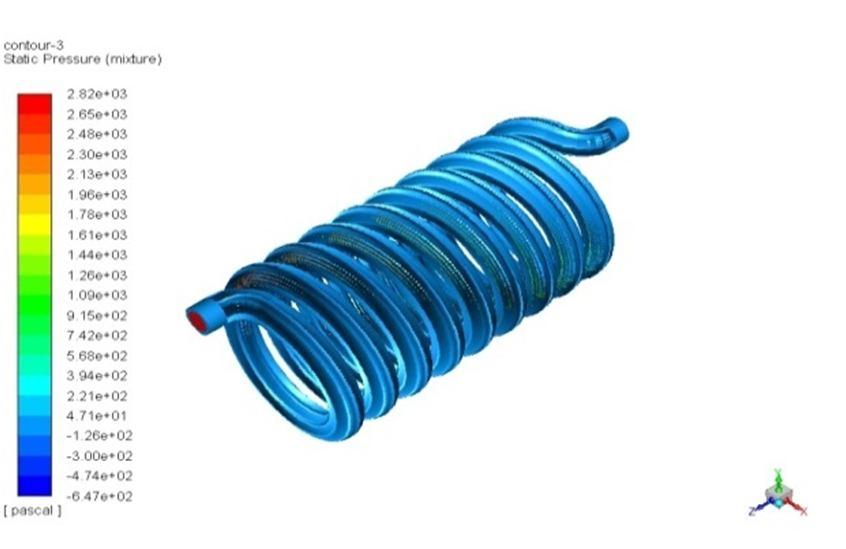
17 minute read
Shell Length 215 mm
from Analysis and Comparison of Shell and Helical Coil Heat Exchanger by Using Silica and Alumina
by IJRASET
Table 2 : Shell and Helical Coil Meshing Statistics
Mesh type Fine grid mesh No. of nodes 166108 No. of elements 287186
Advertisement
STEP 2 Fluent Setup: After mesh setup generation define the following steps in the ANSYS fluent 18.2. Problem Type -3D solid Type of Solver – pressure Physical Model – viscous k- two equation turbulence model Mixture- mixture STEP 3 Fluid Property
Table No. 3 Property of Al2O3 Nanofluid Type of fluid Al2O3 Density (ρ) 3600 kg/m3 Viscosity (µ) 0.0001548 kg/m-s Specific heat (Cp ) 765 J/Kg-K Thermal conductivity ( k) 36 Watt/mK
Type of fluid Density (ρ) Viscosity (µ) Specific heat (Cp ) Thermal conductivity (k) Table No 4 Property of Water
Water 998.2 kg/m3 0.2 kg/m-s 1670 J/Kg-K 0.162 Watt/mK
Type of fluid Density (ρ) Viscosity (µ) Specific heat (Cp ) Thermal conductivity ( k) Table No.5 Property of SiO2 Nanofluid
SiO2 2196.7 kg/m3 0.00189 kg/m-s 880 J/Kg-K 30 Watt/mK
SOLUTION Solution Method Pressure - Velocity - Coupling – Scheme - Simple Pressure – standard pressure Momentum- 2nd order Turbulence –kinetic energy 2nd order Turbulence dissipation rate 2nd order
Solution Initialisation Initiate the solution to get the initial solution for the problem. Run Solution Run the solution by giving 500 number of iteration for solving the convers. Post Processing For viewing and interpret of result, the result can be viewed in various formats like graph, value, animations etc.
IV. RESULTS & DISCUSSION
1) Strain drop data was gathered for the shell and helical warmness exchanger design for the Al2O3 nanofluid with ethylene glycol as its foundation. 2) CFD simulations for the copper shell and helical heat exchanger have been completed. 3) overall performance metrics used in all circumstances to evaluate pressure drop and temperature distribution static pressure effects on warm fluid for shell and helical coil warmth exchangers using alumina as a nanofluid and water as its foundation 4) static pressure effects on warm fluid for shell and helical coil warmth exchangers using alumina as a nanofluid and water as its foundation
TABLE 6 Effects of static pressure in hot fluid Case Fluid Pressure drop (Pa)
1 Al2O3 Nano fluid 2820
5) Effects of static pressure on cold fluid for shell and helical coil heat exchanger when alumina is used as a nanofluid and water as its base.
TABLE 7 Effects of static pressure in cold fluid. Case Fluid Pressure drop (Pa)
1 Al2O3 Nano fluid 1448
6) Effects of total pressure on hot fluid for shell and helical coil heat when alumina is used as a nanofluid and water as its base.
TABLE 8 Effects of Total Pressure in hot fluid.
Case Fluid Pressure drop (Pa)
1 Al2O3 Nano fluid 2999.4
7) Effects of total pressure on cold fluid for shell and helical coil heat exchanger when alumina is used as a nanofluid and water as its base
TABLE 9 Effects of Total Pressure in cold fluid.
Case Fluid Pressure drop (Pa)
1 Al2O3 Nano fluid 1708
8) Effects of static temperature on hot fluid for shell and helical coil heat exchanger when alumina is used as a nanofluid and water as its base.
TABLE 10 Effects of static temperature in hot fluid. Case Fluid Temperature (K)
1 Al2O3 Nano fluid 342.5
9) Effects of static temperature on cold fluid for shell and helical coil heat exchanger when alumina is used as a nanofluid and water as its base.
TABLE 11 Effects of static temperature in cold fluid. Case Fluid Temperature (K)
1 Al2O3 Nano fluid 326.7
10) Effects of total temperature on hot fluid for shell and helical coil heat exchanger when alumina is used as a nanofluid and water as its base .
TABLE 12 Effects of total temperature in hot fluid. Case Fluid Temperature (K)
1 Al2O3 Nano fluid 343.7
11) Effect of total temperature on cold fluid for shell and helical coil heat exchanger when alumina is used as a nanofluid and water as its base.
TABLE 13 Effects of total temperature in cold fluid. Case Fluid Temperature (K)
1 Al2O3 Nano fluid 322.9
12) Effects of static pressure on hot fluid for shell and helical coil heat exchanger when silica is used as a nanofluid and water as its base.
TABLE 14 Effects of static pressure in hot fluid Case Fluid Pressure drop (Pa)
1 SiO2 Nano fluid 2483
13) Effects of static pressure on cold fluid for shell and helical coil heat exchanger when silica is used as a nanofluid and water as its base.
TABLE 15 Effects of static pressure in cold fluid. Case Fluid Pressure drop (Pa)
1 SiO2 Nano fluid 1558
14) Effects of total pressure on hot fluid for shell and helical coil heat exchanger when silica is used as a nanofluid and water as its base.
TABLE 16 Effects of Total Pressure in hot fluid. Case Fluid Pressure drop (Pa)
1 SiO2 Nano fluid 2548
15) Effects of total pressure on cold fluid for shell and helical coil heat exchanger when silica is used as a nanofluid and water as its base.
TABLE 17 Effects of Total Pressure in cold fluid. Case Fluid Pressure drop (Pa)
1 SiO2 Nano fluid 1038
16) Effects of static temperature on hot fluid for shell and helical coil heat exchanger when silica is used as a nanofluid and water as its base.
TABLE 18 Effects of static temperature in hot fluid. Case Fluid Temperature (K)
1 SiO2 Nano fluid 332
17) Effects of static temperature on cold fluid for shell and helical coil heat exchanger when silica is used as a nanofluid and water as its base.
TABLE 19 Effects of static temperature in cold fluid. Case Fluid Temperature (K)
1 SiO2 Nano fluid 329
18) Effects of total temperature on hot fluid for shell and helical coil heat exchanger when silica is used as a nanofluid and water as its base .
TABLE 20 Effects of total temperature in hot fluid. Case Fluid Temperature (K)
1 SiO2 Nano fluid 337.4
19) Effects of total temperature on cold fluid for shell and helical coil heat exchanger when silica is used as a nanofluid and water as its base.
TABLE 21 Effects of total temperature in cold fluid. Case Fluid Temperature (K)
1 SiO2 Nano fluid 334.1
Case-1 Al2O3 nanofluid is used as water as its base fluid in shell and helical coil, Static Pressure drop by using hot fluid when mass flow rate is 0.05m/s
Figure-4 Static pressure in shell and helical coil for hot fluid
The largest stress reduction obtained is 2820 Pa. The strain drop is originally 47.1 Pa at the lowest region of the coil and 221 Pa at the middle portion, with a 173.nine Pa rise in pressure drop from lower to centre part of coil. The strain drop from 221 Pa to 2820 Pa is steadily increasing from the centre to the pinnacle of the coil, and the mass glide rate is 0.05m/s. Case-2 Al2O3 nanofluid is used as ethylene glycol as its base fluid in shell and helical coil, Static Pressure drop by using cold fluid when mass flow is 0.05m/s.
Figure-5 Static pressure in shell and helical coil for cold fluid
Case-3 Al2O3 nanofluid is used as ethylene glycol as its base fluid in shell and helical coil, Total Pressure drop by using hot fluid when mass flow rate is 0.05m/s.
Figure-6 Total pressure in shell and helical coil for hot fluid
Case-4 Al2O3 nanofluid is used as ethylene glycol as its base fluid in shell and helical coil, Total Pressure drop by using cold fluid when mass flow rate is 0.05m/s.
Figure-7 Total pressure in shell and helical coil for cold fluid
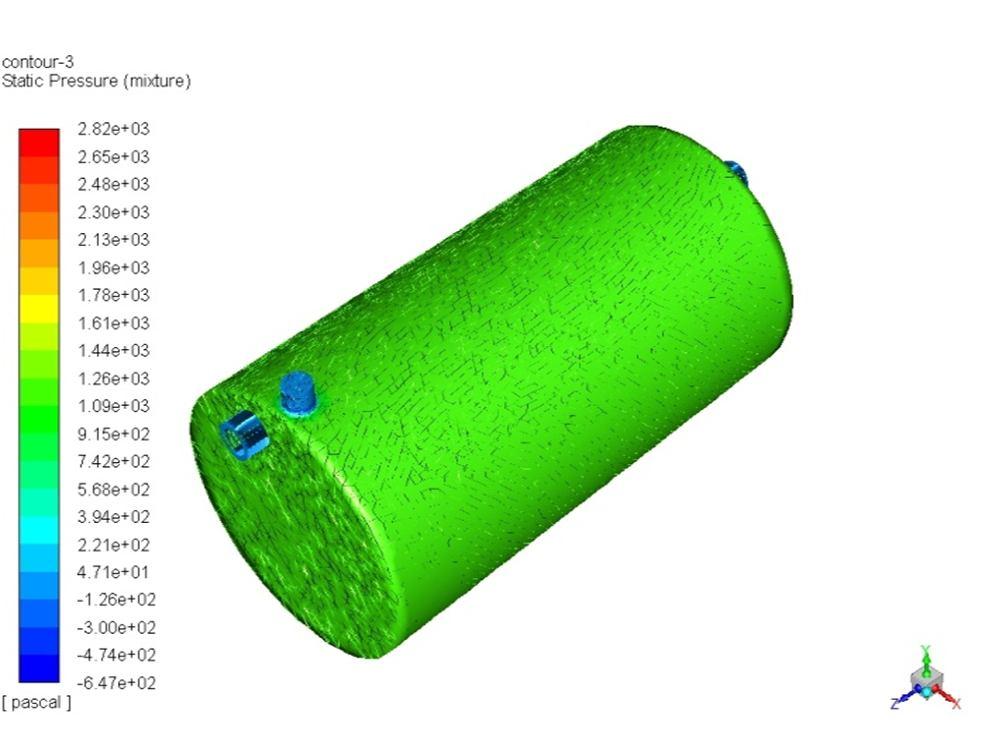
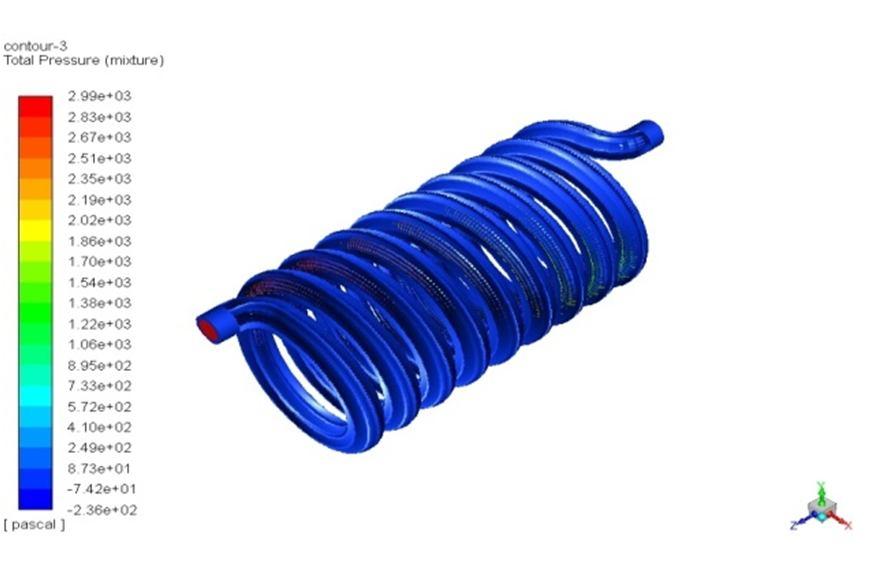
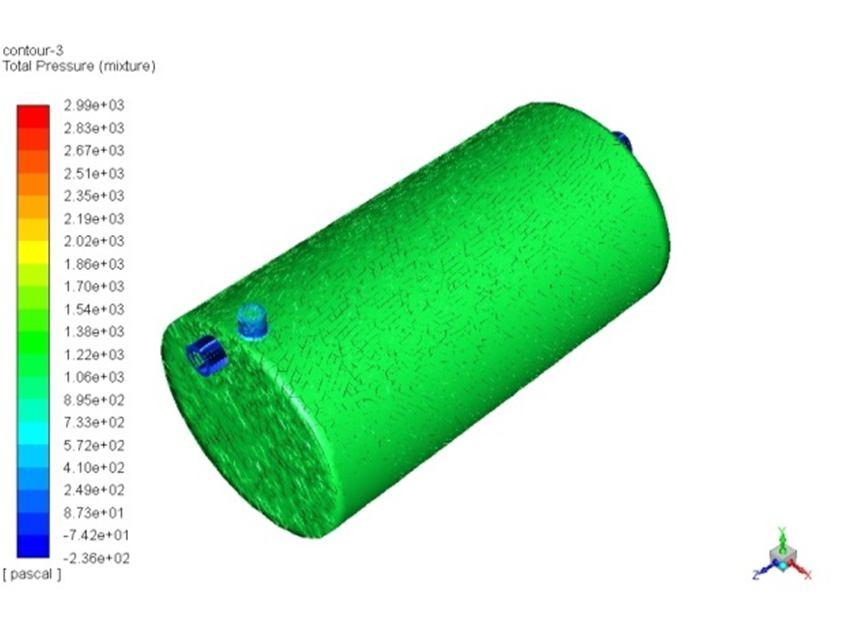
Case-5 Al2O3 nanofluid is used as ethylene glycol as its base fluid in shell and helical coil, Static Temperature by using hot fluid when mass flow rate is 0.05m/s.
Figure-8 Static Temperature in shell and helical coil for hot fluid
Case-6 Al2O3 nanofluid is used as ethylene glycol as its base fluid in shell and helical coil, Static Temperature by using cold fluid when mass flow rate is 0.05m/s.
Figure-9 Static Temperature in shell and helical coil for cold fluid
Case-7 Al2O3 nanofluid is used as ethylene glycol as its base fluid in shell and helical coil, TotalTemperature by using hot fluid when mass flow rate is 0.05m/s.
Figure-10 Total Temperature in shell and helical coil for hot fluid
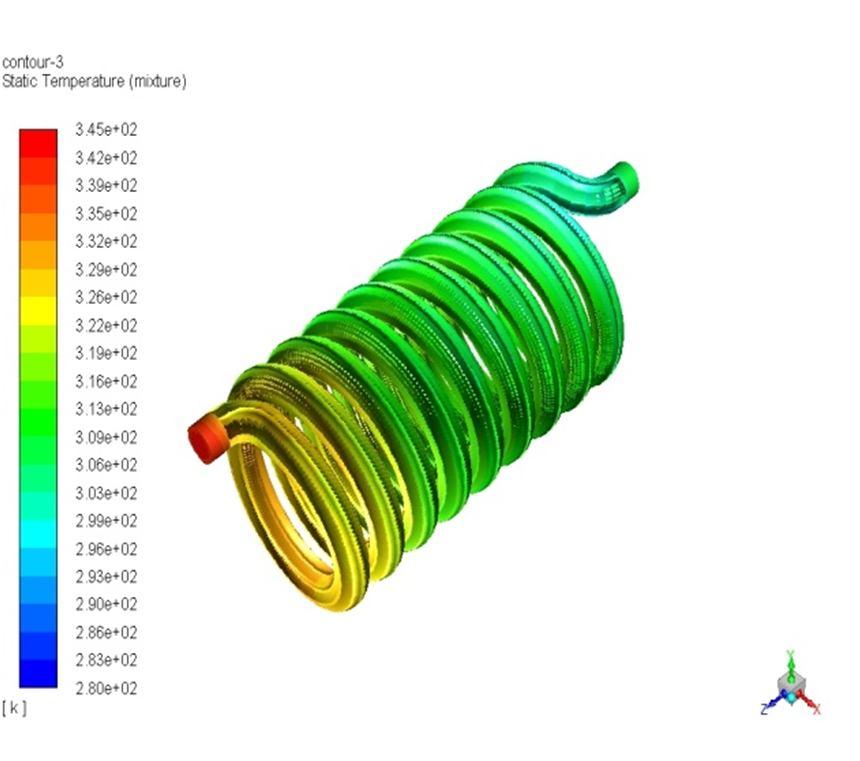
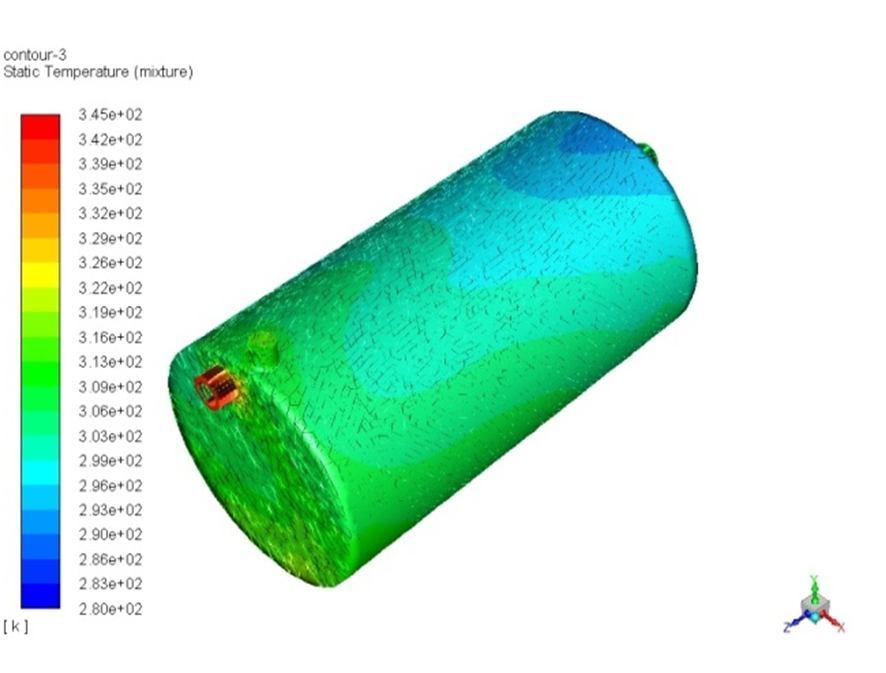
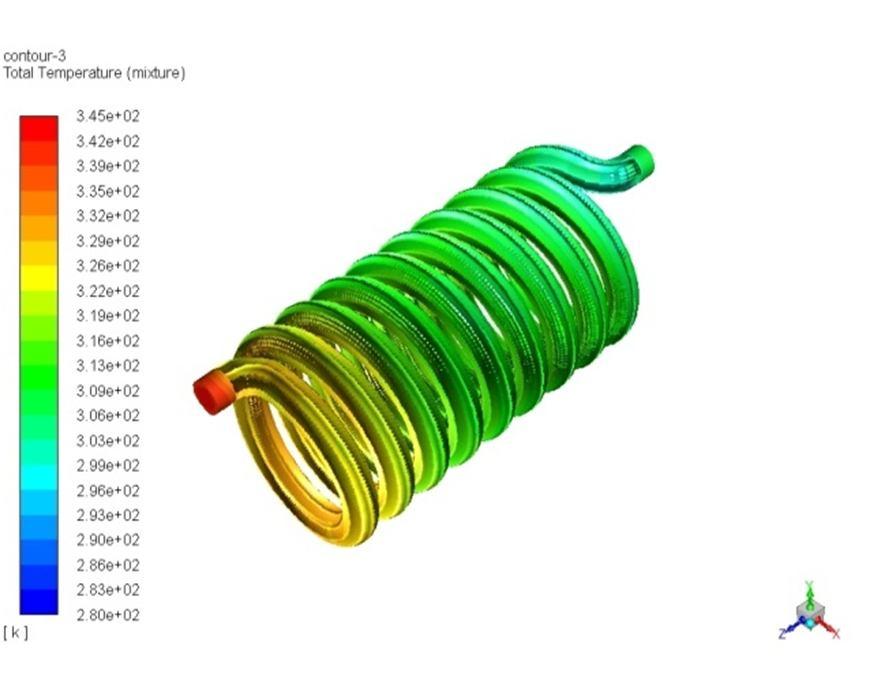
Case-8 Al2O3 nanofluid is used as ethylene glycol as its base fluid in shell and helical coil, TotalTemperature by using cold fluid when mass flow rate is 0.05m/s.
Figure-11 Total Temperature in shell and helical coil for cold fluid
Case-9 SiO2 nanofluid is used as water as its base fluid in shell and helical coil, static pressure by using hot fluid when mass flow rate is 0.05m/s.
Figure-12 Static pressure in shell and helical coil for hot fluid
Case-10 SiO2 nanofluid is used as water as its base fluid in shell and helical coil, Static pressure by using cold fluid when mass flow rate is 0.05m/s.
Figure-13 Static Pressure in shell and helical coil for cold fluid
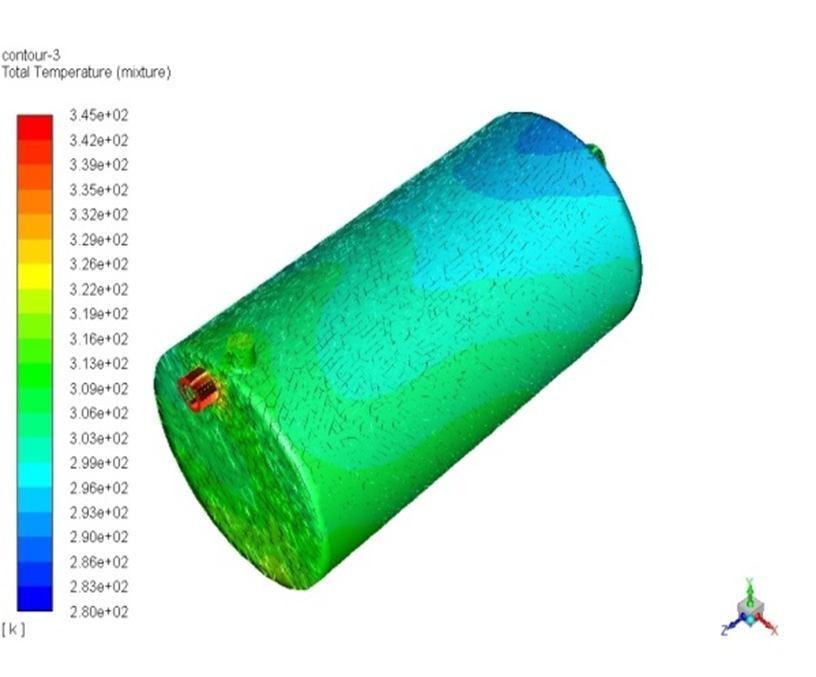
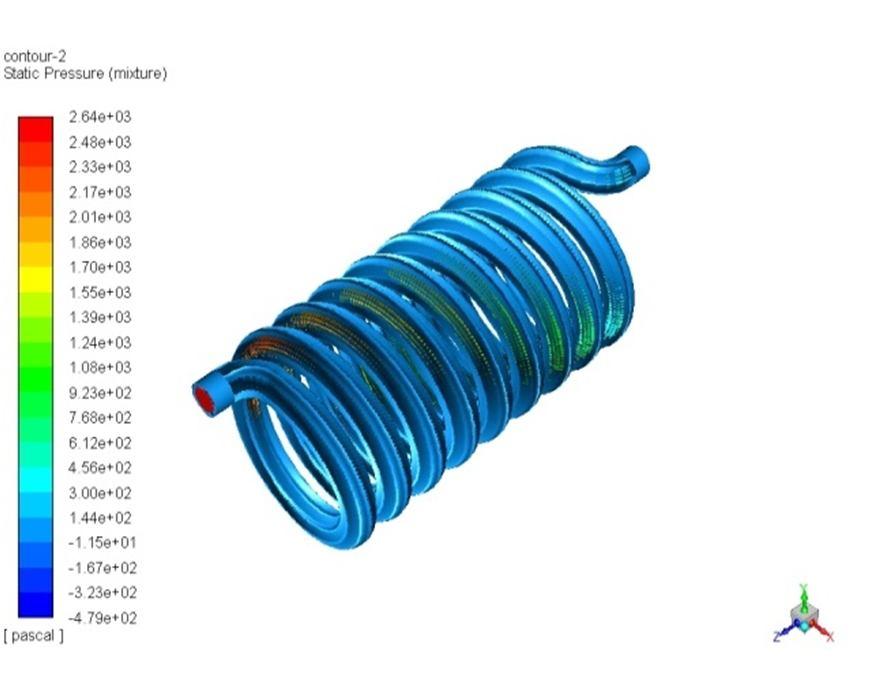
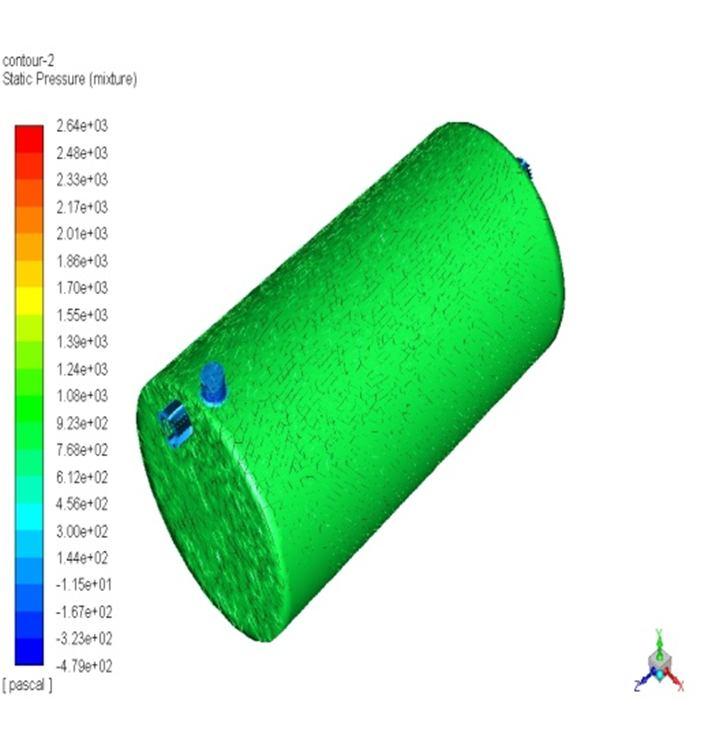
Case-11 SiO2 nanofluid is used as water as its base fluid in shell and helical coil, Total Pressure drop by using hot fluid when mass flow rate is 0.05 m/s.
Figure 14 Total pressure in shell and helical coil for hot fluid
Case-12 SiO2 nanofluid is used as water as its base fluid in shell and helical coil, Total Pressure drop by using cold fluid when mass flow rate is 0.05 m/s
Figure 15 Total pressure in shell and helical coil for cold fluid
Case-13 SiO2 nanofluid is used as water as its base fluid in shell and helical coil, Static Temperature by using hot fluid when mass flow rate is 0.05 m/s.
Figure 16 Static Temperature in shell and helical coil for hot fluid
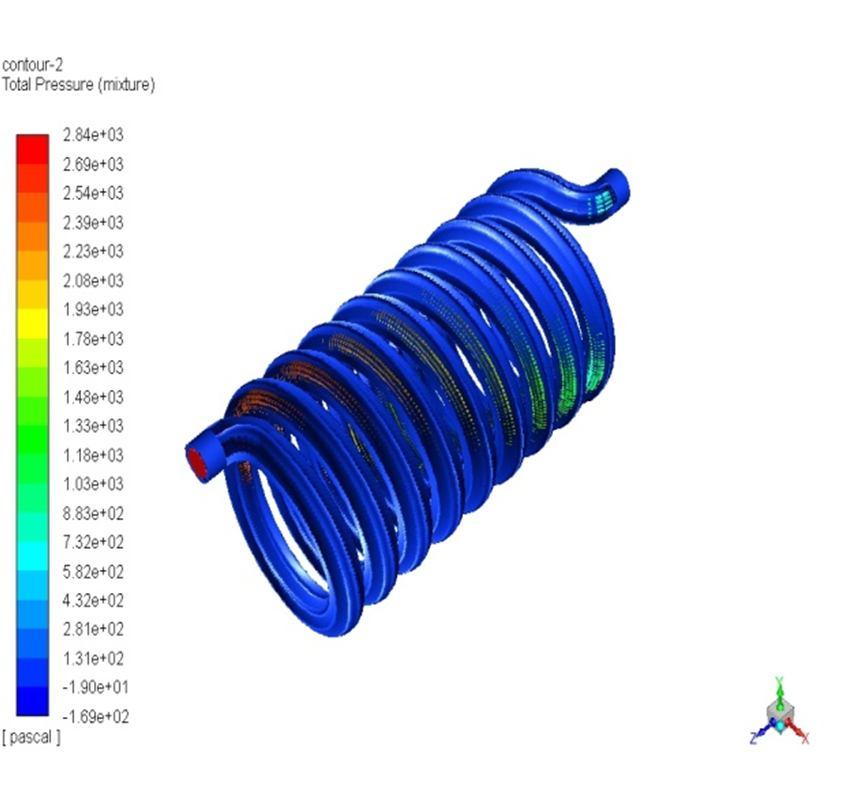
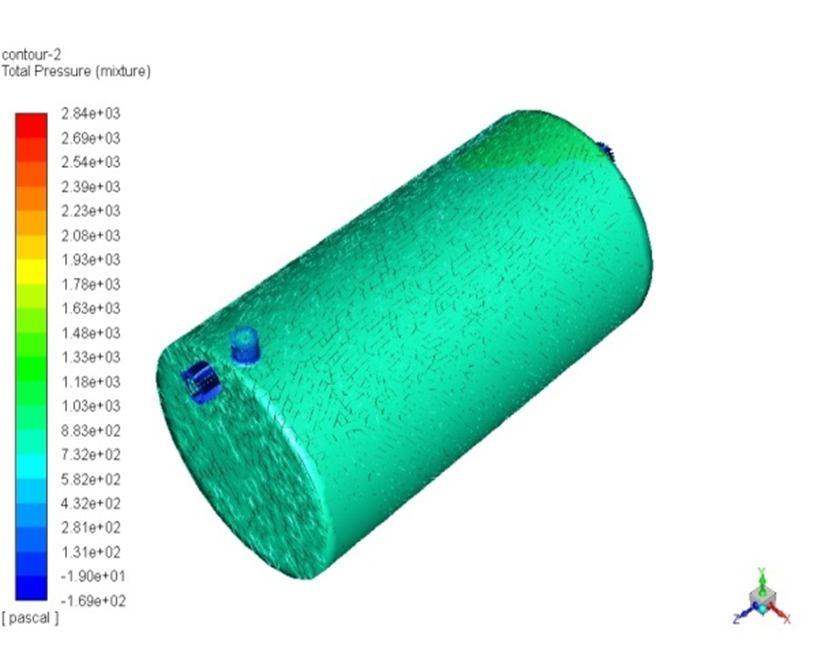
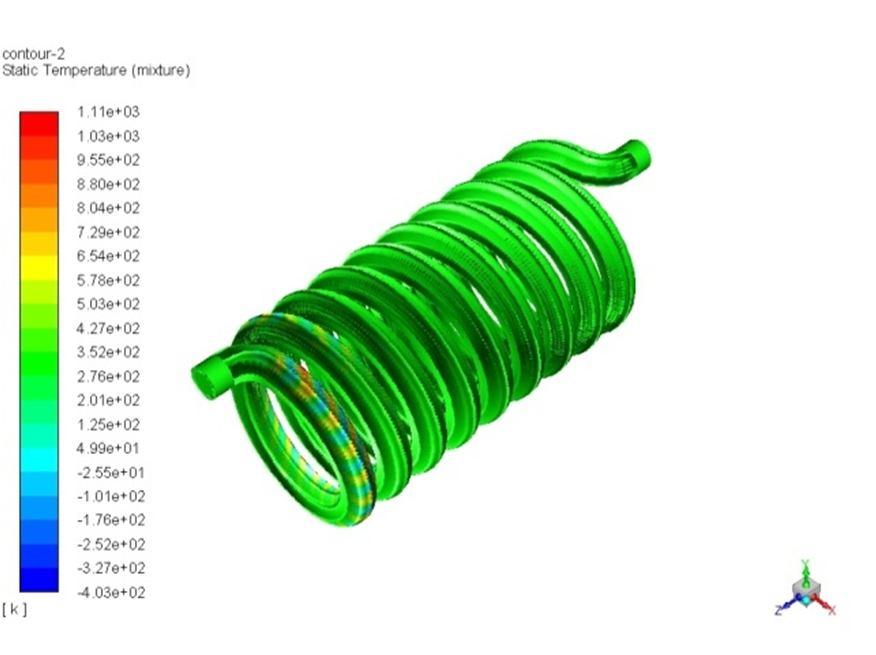
Case-14 SiO2 nanofluid is used as water as its base fluid in shell and helical coil, Static Temperature by using hot fluid when mass flow rate is 0.05 m/s.
Figure 17 Static Temperature in shell and helical coil for cold fluid
Case-15 SiO2 nanofluid is used as water as its base fluid in shell and helical coil, total Temperature by using cold fluid when mass flow rate is 0.05 m/s.
Figure 18 Total Temperature in shell and helical coil for hot fluid
Case-16 SiO2 nanofluid is used as water as its base fluid in shell and helical coil, TotalTemperature by using cold fluid when mass flow rate is 0.05 m/s.
Figure 19 Total Temperature in shell and helical coil for hot fluid

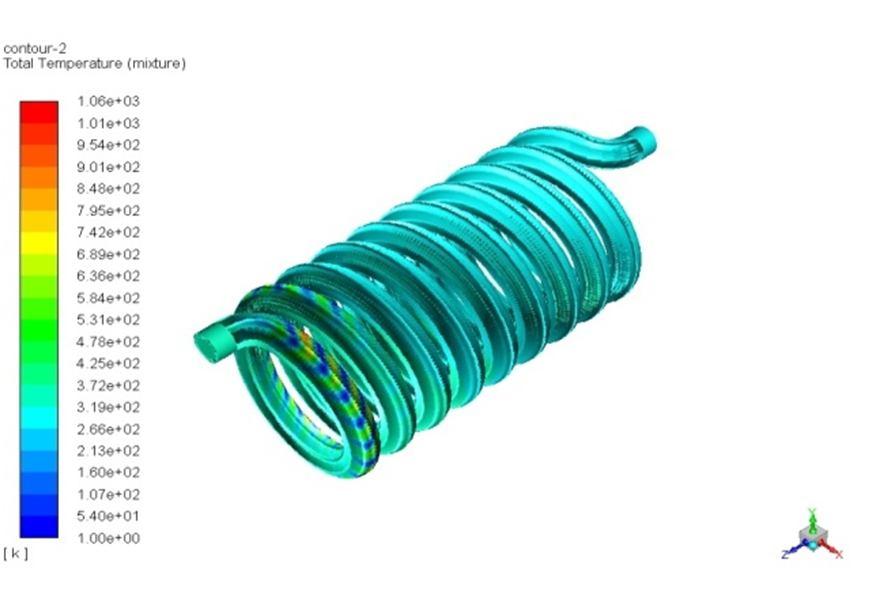
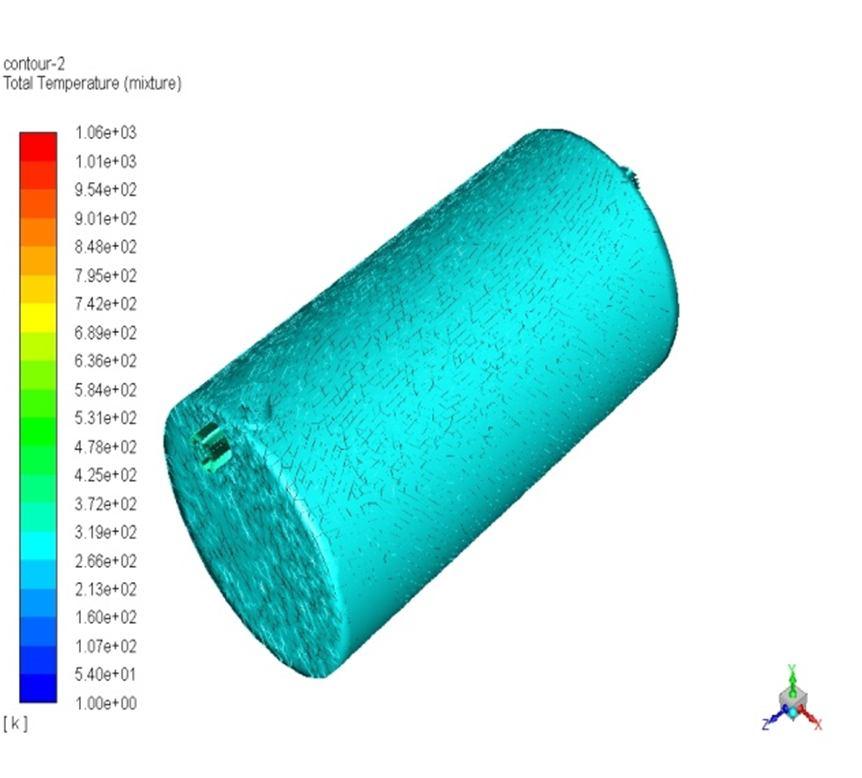
Properties Table No.22 CFD Analysis results
Al2O3 Nanofluid using ethylene glycol as its base
Max static pressure on the shell and helical coil heat exchanger when mass flow rate is 0.05 m/s and Al2O3 nanofluid is used as water as its base.
Max static pressure on the shell and helical coil heat exchanger when mass flow rate is 0.05 m/s and Al2O3 nanofluid is used as water as its base. Max total pressure on the shell and helical coil heat exchanger when mass flow rate is 0.05 m/s and Al2O3 nanofluid is used as water as its base. Max total pressure on the shell and helical coil heat exchanger when mass flow rate is 0.05 m/s and Al2O3 nanofluid is used as water as its base. Max static temperature on the shell and helical coil heat exchanger when mass flow rate is 0.05 m/s and Al2O3 nanofluid is used as water as its base. Max static temperature on the shell and helical coil heat exchanger when mass flow rate is 0.05 m/s and Al2O3 nanofluid is used as water as its base. Max total temperature on the shell and helical coil heat exchanger when mass flow rate is 0.05 m/s and Al2O3 nanofluid is used as water as its base. Max total temperature on the shell and helical coil heat exchanger when mass flow rate is 0.05 m/s and Al2O3 nanofluid is used as water as its base. Max static pressure on the shell and helical coil heat exchanger when mass flow rate is 0.05m/s and SiO2 nanofluid is used as water as its base Max static pressure on the shell and helical coil heat exchanger when mass flow rate is 0.05m/s and SiO2 nanofluid is used as water as its base Max total pressure on the shell and helical coil heat exchanger when mass flow rate is 0.05m/s and SiO2 2820 Pa
1448 Pa
2999.4 Pa
1708 Pa
342.5 K
326.7 K
343.7 K
322.9 K
2483 Pa
1558 Pa
2548 Pa
nanofluid is used as water as its base Max total pressure on the shell and helical coil heat exchanger when mass flow rate is 0.05m/s and SiO2 nanofluid is used as water as its base Max static temperature on the shell and helical coil heat exchanger when mass flow rate is 0.05m/s and SiO2 nanofluid is used as water as its base Max static temperature on the shell and helical coil heat exchanger when mass flow rate is 0.05m/s and SiO2 nanofluid is used as water as its base Max total temperature on the shell and helical coil heat exchanger when mass flow rate is 0.05m/s and SiO2 nanofluid is used as water as its base Max total temperature on the shell and helical coil heat exchanger when mass flow rate is 0.05m/s and SiO2 nanofluid is used as water as its base 1038 Pa
332 K
329 K
337.4 K
334.1 K
V. CONCLUSION
In this paper, analytical investigations are done on the shell and helical coil heat exchanger, to determine pressure drop and temperature distribution of a water as a base fluid and Al2O3 and SiO2 as a nanofluid on shell and helical coil flowing under laminar flow conditions. By observing the CFD analysis results, the pressure drop is more in hot fluid of Al2O3 and SiO2 nanofluid with water as a base fluid in shell and helical coil heat exchanger.
REFERENCES
[1] Pranita Bichkar*, Ojas Dandgaval, Pranita Dalvi, Rhushabh Godase and Tapobrata Dey* 2018, “Study of Shell and Tube Heat Exchanger with the effect of types of baffles.” Elsevier Procedia Manufacturing 20 (2018) 195–200. [2] Y.G. Lei, Y.L. He, R. Li, Y.F. Gao, Effects of baffle inclination angle on flow and heat transfer of a heat exchanger with helical baffles, Chem. Eng. Process. 47 (12) (2008) 2336–2345. [3] Vidula Vishnu Suryawanshi, Nikhil Ghodake, Onkar Patil, Sham Lomate, Shital.G.Nerkar, 2021, “Design and analysis of Helical coil Heat Exchanger”, [4] International Journal of Engineering Research in Mechanical and Civil Engineering volume 6 Issue 8. [5] Vishal Momale, Aditya Wankhade , Prajakta Kachare, 2019, “ Performance analysis of conical helical tube heat exchanger with straight and conical shell using cfd”, Journal of Emerging Technologies and Innovative Research, Volume 6, Issue 1. [6] M. Ali, “Experimental investigation of natural convection from vertical helical coiled tubes,” International Journal of Heat and mass transfer, volume 37, pages 665-671, 1994. [7] R.K. Patil, R.W. Shende and P.K. Ghosh, “Designing a helical- coil heat exchanger,” Chemical Engineering, pages 85-88, 1982. [8] N. Ghorbani, H. Taherian, M. Gorji and H. Mirgolbabaei , “Experimental study of mixed convection heat transfer in vertical helically coiled tube heat exchangers,” Experimental Thermal and Fluid Science, volume 34, issue 7, Pages 900-905, oct 2010 [9] Sunil Kumar, Dr. DK Gupta 2020, “Optimising Design and analysis on the Helically Coiled Tube Heat Exchanger carrying Nanofluids by providing fins”
Smart Moves Journal IJO Science, Volume 6, Page 23-31. [10] K. Abdul Hamid, W. H. Azmi, RIzalman Mamat, N. A. Usri and Gohalamhassan Najafi 2015, “Effect of Titanium Oxide Nanofluid Concentration on Pressure drop” ARPN Journal of Engineering and Applied Sciences, Volume 10, Page 7815-7820. [11] Palanisamy, K. P.C. Mukesh Kumar 2019, “Experimental investigation on convective heat transfer and pressure drop of cone helically coiled tube heat exchanger using carbon nanotubes/ water nanofluids”, Elsevier – Heliyon 5. [12] Hemasunder Banka, Dr. V. Vikram Reddy, M. Radhika 2016, “CFD Analysis of Shell and Tube Heat Exchanger using Titanium Carbide, Titanium Nitride and
Zinc Oxide Nanofluid” International Journal of Innovations in Engineering and Technology, Special Issue, Page 315-322. [13] Jaafar Albadr, Satinder Tayal, Mushtaq Alasadi 2013 “Heat transfer through heat exchanger using Al2O3 nanofluid at different concentrations” Elsevier,
Volume-1, Page 38-44. [14] Shiva Kumar, K Vasudev Karanth 2013, “Numerical analysis of a Helical Coiled Heat Exchanger using CFD” International Journal of Thermal Technologies,
Volume 3, Page 126-130.
[15] M. Balachandaran 2015, “Experimental and CFD study of a Helical Coil Heat Exchanger using Water as Fluid” International Journal of Mechanical and
Production Engineering, Volume 3, Page 87-91. [16] Vinita Sisodiya, Dr. Ankur Geete 2016 “Heat Transfer analysis of Helical coil Heat Exchanger with Al2O3 Nanofluid” International Journal of Engineering and
Technology, Volume 3, Page 366-370. [17] Fakoor-Pakdaman, M.A. Akhavan- Behabadi,P. Razi 2013, “An empirical study on the pressure drop characteristics of Nanofluid flow inside helically coiled tubes” International Journal of Thermal Sciences, Volume 65, Page 206-213. [18] Ashkan Alimoradi 2017, “Study of thermal effectiveness and its relation with NTU in Shell and helically coiled tube heat exchanger” Elsevier Case Studies in
Thermal Engineering, Volume 9, Page 100–107. [19] Tushar A. Sinha, Amit Kumar, Nikhilesh Bhargava and Soumya S Mallick 2014, “An Experimental Investigation into the Thermal Properties of Nano Fluid”
Applied Mechanical Engineering, Volume 4, Issue 1. [20] Jayakumar J. S., S.M. Mahajani, J.C. Mandal, P.K. Vijayan, Rohidas Bhoi, 2008, “Experimental and CFD estimation of heat transfer in helically coiled heat exchangers” Chemical Engineering Research and Design, Volume 86, Page 221-232. [21] Amar Raj Singh Suri, Anil Kumar, Rajesh Maithani 2017, “Effect of square wings in multiple square perforated twisted tapes on fluid flow and heat transfer of heat exchanger tube” Elsevier Case Studies in Thermal Engineering, Volume 10, Page 28-43. [22] Ram Kishan, Devendra Singh, Ajay Kumar Sharma 2020, “CFD Analysis of Heat Echanger using Ansys Fluent”, International Journal of Mechanical
Engineering and Technology”, Volume 11, Page 1-9. [23] B. Chinna Ankanna, B. Sidda Reddy 2014, “Performance Analysis of Fabricated Helical Coil Heat Exchanger”, International Journal of Engineering &
Research, Volume 3, Page 33-39. [24] Changnian Chen, Jitian Han and Li Shao 2017 “The characteristics of Pressure Drop and Heat transfer of Coils Used in Solar Collectors” Elsevier, Volume-7,
Page 351-357. [25] Baghel Rakesh & Upadhayaya Sushant. Effect of coil diameter in archimedan spiral coil. International journal of applied engineering research 2013; Vol. 8: pp. 2151- 2156. [26] Ankanna Chinna B, Reddy Sidda B. Performance analysis of fabricated helical coil heat exchanger. International journal of engineering research 2014; Vol. 3: pp.33-39. [27] Pramod Deshmukh, Vikram D Patil, Prof. Baviskar Devakant 2016 “CFD analysis of heat transfer in helical coil tube in tube heat exchanger” International
Journal of Innovation in Engineering Research and Technology, Volume 3, Issue 1. [28] A K Singh 2008 “Thermal Conductivity of Nano fluids” Defence Science Journal, Volume 58, Page 600-607. [29] Amol Bari, Hemant Bhutte, Nirmal Waykole, Ajeet Yadav, Swapnil Mane 2016 “Study of tube in tube concentric parallel flow heat exchanger using nanofluid”
International Journal of Advanced Research, Volume 4, Page 1376-1383. [30] Murali Krishna 2016 “Heat Transfer Enhancement by using ZnO Water Nanofluid in a Concentric Tube Heat Exchanger under Forced Convection Conditions”
International Journal of Innovations in Engineering and Technology, Volume-7, Page 177-184. [31] Prof. Alpesh Mehta1, Dinesh k Tantia , Nilesh M Jha , Nimit M Patel 2012 “Heat Exchanger using Nano Fluid” International Journal of Advanced Engineering
Technology, Volume 3, Page 49-54. [32] Kevin Kunnassery, Rishabh Singh, Sameer Jackeray 2017 “Experimental analysis of helical coil heat exchanger by using different compositions of nano fluids”
International Journal of Innovative and Emerging Research in Engineering, Volume-4, Page 219-229. [33] Vishwas M. Palve, Prof. Rajesh V. Kale 2015 “Computational analysis of helical coil Heat exchanger for Temperature and Pressure drop” International
Research Journal of Engineering and Technology, Volume-2, Page 162-166. [34] Amitkumar S. Puttewar , A.M. Andhare 2015 “Design and thermal evaluation of Shell and Helical coil Heat exchanger” International Journal of Research in
Engineering and Technology,Volume-4, Page 416-423.





